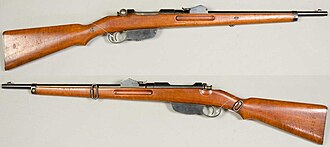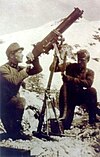Mannlicher M1890 Carbine
| Repeating Carbine Model 1890 | |
|---|---|
 Model 1890 Cavalry Carbine. From the collections of the Swedish Army Museum. | |
| Type | Bolt action rifle |
| Place of origin | Austria-Hungary |
| Service history | |
| In service | 1890–1918 (Austria-Hungary) |
| Used by | Austria-Hungary Kingdom of Bulgaria[1] Emirate of Afghanistan[2] Kingdom of Hungary First Austrian Republic Kingdom of Hungary Siam |
| Wars | Balkan Wars World War I |
| Production history | |
| Designer | Ferdinand Mannlicher |
| Designed | 1890? |
| Manufacturer | Österreichische Waffenfabriksgesellschaft |
| Produced | 1891–1896 |
| No. built | 115,218 |
| Variants | Cavalry Carbine, Gendarmerie Carbine and Navy Short Rifle |
| Specifications | |
| Mass | 3.3 kilograms (7.3 lb) |
| Length | 1,005 millimetres (39.6 in) |
| Barrel length | 498 millimetres (19.6 in) |
| Cartridge | M90: 8×50mmR[3] M90/24:8×57mm IS M90/30, M90/31: 8×56mmR |
| Action | Straight-pull bolt action |
| Muzzle velocity | 620 m/s (2,034 ft/s) with M1893 ball cartridge[4] |
| Feed system | 5-round en bloc clip, integral box magazine |
| Sights | Iron sights |
The Repeating Carbine Model 1890 a.k.a. Mannlicher Model 1890 Carbine is a bolt-action rifle, designed by Ferdinand Mannlicher that used a new version of his straight-pull action bolt.[5] It was introduced as an alternative to the Mannlicher M1888 as it was shorter and easier to maneuver with. Three main versions were introduced: Cavalry Carbine, Gendarmerie Carbine[3] and Navy Short Rifle.
Variants

Cavalry Carbine
This variant was used by the Austro-Hungarian cavalry. A stacking rod, handguard and bayonet lug are absent.
Stutzen
This variant features sling swivels on the underside, a stacking rod and bayonet lugs. It was used by the Austro-Hungarian Navy.
Gendarmerie carbine
The Austro-Hungarian Gendarmarie was also in need of a carbine. It adopted a version which featured a bayonet lug but no stacking rod.
Conversions
M90/30 was a conversion of these rifles done in the First Austrian Republic. They carry the letter S stamped on the barrel.[6]
M90/31 was a conversion of these rifles done in the Kingdom of Hungary. They carry the letter H stamped on the barrel.[7]
M90/95 was a conversion of these rifles done in Ethiopian Empire]. Unlike other conversions, these were done by putting existing M90 carbines in M95 pattern furniture. [8]
Afghan Contract
A small number of these carbines made for the Afghan Contract were ordered by Abdur Rahman Khan for the Emirate of Afghanistan.[2]
References
- ^ Philip Jowett (20 March 2012). Armies of the Balkan Wars 1912–13: The priming charge for the Great War. Osprey Publishing. pp. 43–. ISBN 978-1-78096-528-4.
- ^ a b "Afghan Contract Mannlicher M1890 Carbines Austro-Hungarian Weapons".
- ^ a b Walter, John (1998). Rifles of the World. 700 E. State Street Iola, WI 54990: Krause Publications. p. 265. ISBN 0-89689-241-7.
{{cite book}}: CS1 maint: location (link) - ^ Deutsche militärärztliche Zeitschrift: Vierteljährliche Mittellungen aus dem Gebiet des Militär-Sanitäts- und Versorgungswesens. ... . I.-49. Jahrgang. [1872–1920.]. E. S. Mittler & Sohn. 1894. pp. 72–.
- ^ Impact of Science on Society. Vol. 26–27. United Nations Educational, Scientific and Cultural Organization. 1976. p. 64.
- ^ "Mannlicher M90/30 Rifle and Carbine Austro-Hungary".
- ^ "Mannlicher M90/31 Austro-Hungarian Weapons".
- ^ "Ethiopian M90/95 Hybrid Mannlicher Carbine".

Further reading
- United States. Office of Naval Intelligence (1892). "Mannlicher Carbine (Model 1890)". General Information Series: Information from Abroad. U.S. Government Printing Office. pp. 117–.
- Austro-Hungarian Mannlicher M1890 Short Rifles and Carbines. Hungariae.com
- v
- t
- e
| Single-shot | |||||
|---|---|---|---|---|---|
| Repeating |
| ||||
| Automatic |













